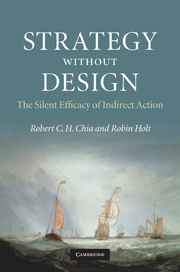Book contents
- Frontmatter
- Contents
- Preface
- Introduction
- 1 Spontaneous order: the roots of strategy emergence
- 2 Economic agency and steps to ecological awareness
- 3 Reconceptualizing agency, self-interest and purposive action
- 4 The ‘practice turn’ in strategy research
- 5 Building and dwelling: two ways of understanding strategy
- 6 Strategy as ‘wayfinding’
- 7 The silent efficacy of indirect action
- Epilogue: Negative capability
- Notes
- Index
Epilogue: Negative capability
Published online by Cambridge University Press: 22 January 2010
- Frontmatter
- Contents
- Preface
- Introduction
- 1 Spontaneous order: the roots of strategy emergence
- 2 Economic agency and steps to ecological awareness
- 3 Reconceptualizing agency, self-interest and purposive action
- 4 The ‘practice turn’ in strategy research
- 5 Building and dwelling: two ways of understanding strategy
- 6 Strategy as ‘wayfinding’
- 7 The silent efficacy of indirect action
- Epilogue: Negative capability
- Notes
- Index
Summary
Throughout this book we have endeavoured to become what Elias Canetti calls writers – Dichter – whose role it is to explore and comment upon experience without fixation. The writer does not collect or build things, but tries to encounter and absorb them as they are, in all their inconsistency and contradiction, and all their latency and potential. The writer is not someone who propounds models if by such are meant institutional designs and outcomes that are deemed desirable irrespective of circumstance. This is the impetus behind our advocacy of strategy without design, a deliberately tense title – unattainable, of course. We all use designs all the time. This book is designed using chapter structures and attributions; it recommends states of affairs; it uses structured arguments to attempt to elicit sympathy. Being without design acts as an impetus, however; it encourages endeavour by those for whom it resonates to strive towards it, ways of thought without the prospect of an end point, or even a resolution. It is in the striving that we experience plenitude, that new qualities arise. For the economist Thorstein Veblen, something akin to this striving, this resistance to fixed goals and ideals, was expressed in his oft-used phrase ‘Whatever is, is wrong’. The more entrenched, orthodox and generally established an idea was the greater the likelihood of its being wrong, because, whilst its appropriateness was always an upshot of our future-oriented activity, its formal or accepted sense languished in unexamined academic and commercial habit.
- Type
- Chapter
- Information
- Strategy without DesignThe Silent Efficacy of Indirect Action, pp. 209 - 212Publisher: Cambridge University PressPrint publication year: 2009



